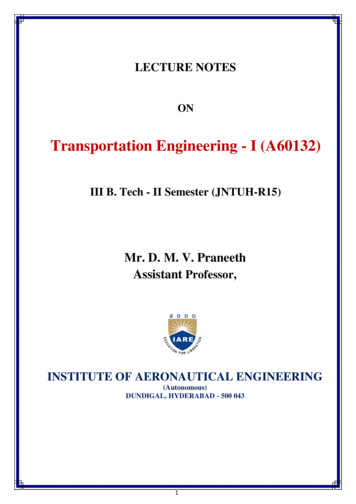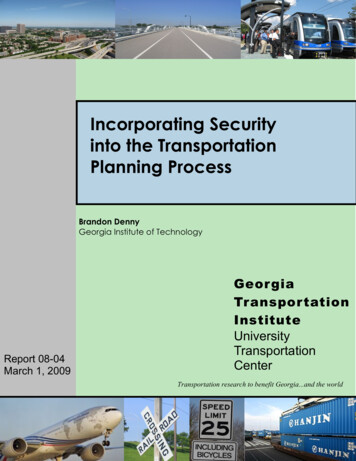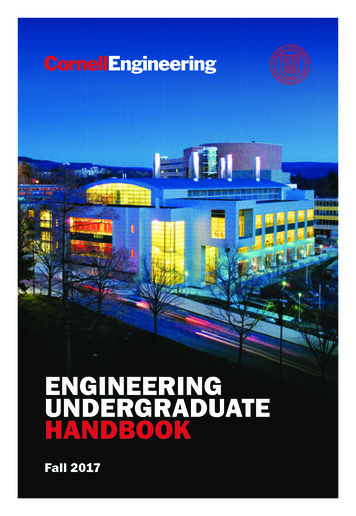
Transcription
LECTURE NOTESONTransportation Engineering - I (A60132)III B. Tech - II Semester (JNTUH-R15)Mr. D. M. V. PraneethAssistant Professor,INSTITUTE OF AERONAUTICAL ENGINEERING(Autonomous)DUNDIGAL, HYDERABAD - 500 0431
CONTENTSUNIT1 HIGHWAY DEVELOPMENT AND PLANNINGHighway development in IndiaNecessity for highway planningDifferent road development plansClassification of roadsRoad network patternsHighway AlignmentFactors affecting alignmentEngineering surveysDrawing and reportsHighway Project.UNIT 2 HIGHWAY GEOMETRIC DESIGNImportance of Geometric DesignFactors affecting highway geometric designDesign controls and CriteriaHighway Cross Section ElementsSight Distance ElementsStopping sight Distance,Overtaking Sight DistanceIntermediate Sight DistanceDesign of Horizontal AlignmentDesign of Super elevationExtra wideningDesign of Transition CurvesDesign of Vertical alignmentGradientsVertical curvesUNIT 3 TRAFFIC ENGINEERING AND REGULATIONBasic Parameters of TrafficVolume, Speed and densityTraffic volume studies-Data collection and presentationSpeed studies –Data collection and presentationOrigin and Destinations studies,Parking StudiesOn street and off-street parkingRoad Accidents –Causes and Preventive measuresAccident Data RecordingCondition Diagram and Collision DiagramsTraffic Signs – Types and SpecificationsRoad markings-Need for Road MarkingsTypes of Road MarkingsDesign of Traffic Signals- Webster method.II
UNIT 4 INTERSECTION DESIGNTypes of IntersectionsConflicts at IntersectionsRequirements of At –Grade intersectionTypes of at-Grade IntersectionsChannelization -Traffic IslandsTypes of Grade Separated IntersectionsRotary Intersection –concept of RotaryDesign factors of rotaryAdvantages and limitations of rotary intersections.UNIT 5 HIGHWAY MATERIAL, CONSTRUCTION ANDMAINTENANCE:Highway material characterizationSub grade soilStone aggregateBitumen materialsConstruction of gravel roadConstruction of water bound macadam roadConstruction of bituminous pavementsSurface dressinNgBitumen bound macadamBituminous concreteConstruction of cement concrete pavementsConstruction of joints in cement concrete pavementsJoint filter and sealPavement failuresMaintenance of highwaysHighway Drainage.II
UNIT 1HIGHWAY DEVELOPMENT AND PLANNING4
UNIT 1HIGHWAY DEVELOPMENT AND PLANNINGOverviewRoad transport is one of the most common modes of transport. Roads in the form of track ways,human pathways etc. were used even from the pre-historic times. Since then many experimentswere going on to make the riding safe and comfort. Thus road construction became an inseparablepart of many civilizations and empires. In this chapter we will see the different generations of roadand their characteristic features. Also we will discuss about the highway planning in India.History of highway engineeringThe history of highway engineering gives us an idea about the roads of ancient times. Roads inRome were constructed in a large scale and it radiated in many directions helping them in militaryoperations. Thus they are considered to be pioneers in road construction. In this section we will seein detail about Ancient roads, Roman roads, British roads, French roads etc.Ancient RoadsThe earliest mode of transport was by foot. These human pathways would have been developed forspecific purposes leading to camp sites, food, streams for drinking water etc. The next major modeof transport was the use of animals for transporting both men and materials. Since these loadedanimals required more horizontal and vertical clearances than the walking man, track waysemerged. The invention of wheel in Mesopotamian civilization led to the development of animaldrawn vehicles. Then it became necessary that the road surface should be capable of carryinggreater loads. Thus roads with harder surfaces emerged. To provide adequate strength to carry thewheels, the new ways tended to follow the sunny drier side of a path. These have led to thedevelopment of foot-paths. After the invention of wheel, animal drawn vehicles were developed andthe need for hard surface road emerged. Traces of such hard roads were obtained from variousancient civilization dated as old as 3500 BC. The earliest authentic record of road was found fromAssyrian empire constructed about 1900 BC.Roman roadsThe earliest large scale road construction is attributed to Romans who constructed an extensivesystem of roads radiating in many directions from Rome. They were a remarkable achievement andprovided travel times across5
2.7 mSloping Wearing Surface 5cm thickShoulder Slope 1:20Side drainBroken stones 8cm thickLarge foundation stones on edge17cm thickFigure 1.1: French roadsEurope, Asia Minor, and North Africa. Romans recognized that the fundamentals of good roadconstruction were to provide good drainage, good material and good workmanship. Their roadswere very durable, and some still exist. Roman roads were always constructed on a ram - formedsub grade strengthened where necessary with wooden piles. The roads were bordered on both sidesby longitudinal drains. The next step was the construction of the aggregate. This was a raisedformation up to a 1 meter high and 15 m wide and was constructed with materials excavated duringthe side drain construction. This was then topped with a sand leveling course. The aggregatecontributed greatly to moisture control in the pavement. The pavement structure on the top of theaggregate varied greatly. In the case of heavy traffic, a surface course of large 250 mm thickhexagonal ag stones were provided. A typical cross section of roman road is given in Figure 1:1 Themain features of the Roman roads are that they were built straight regardless of gradient and usedheavy foundation stones at the bottom. They mixed lime and volcanic puzzolana to make mortarand they added gravel to this mortar to make concrete. Thus concrete was a major Roman roadmaking innovation.2.2.3French roadsThe next major development in the road construction occurred during the regime of Napoleon. Thesigni cant contributions were given by Tresaguet in 1764 and a typical cross section of this road isgiven in Figure 1:2. He developed a cheaper method of construction than the lavish and locallyunsuccessful revival of Roman practice. The pavement used 200 mm pieces of quarried stone of amore compact form and shaped such that they had at least one at side which was placed on acompact formation. Smaller pieces of broken stones were then compacted into the spaces betweenlarger stones to provide a level surface. Finally the running layer was made with a layer of 25 mmsized broken stone. All this structure was placed in a trench in order to keep the running surface6
level with the surrounding country side. This created major drainage problems which werecounteracted by making the surface as impervious as possible, cambering the surface and providingdeep side ditches.4.5 mCross slopeSide drainCompactedSubgradeslope1:3650mm Broken Stones, 100mm thick37.5mm Broken Stones, 100mm thickSurface Course 20mm, 50mm thickFigure 1:2: British roadsHe gave much importance for drainage. He also enunciated the necessity for continuous organizedmaintenance, instead of intermittent repairs if the roads were to be kept usable all times. For this hedivided the roads between villages into sections of such length that an entire road could be coveredby maintenance men living nearby.2.2.4 British roadsThe British government also gave importance to road construction. The British engineer JohnMacadam introduced what can be considered as the best scientific road construction method. Stonesize was an important element of Macadam recipe. By empirical observation of many roads, hecame to realize that 250 mm layers of well compacted broken angular stone would provide the samestrength and stiffness and a better running surface than an expensive pavement founded on largestone blocks. Thus he introduced an economical method of road construction.The mechanical interlock between the individual stone pieces provided strength and stiffness tothe course. But the inter particle friction abraded the sharp interlocking faces and partly destroy thee activeness’ of the course. This was overcome by introducing good quality interstitial ner materialto produce a well-graded mix. Such mixes also proved less permeable and easier to compact. Atypical cross section of British roads is given in Figure 1:2.2.2.5 Modern roadsThe modern roads by and large follow Macadam's construction method. Use of bituminous concreteand cement concrete are the most important developments. Various advanced and cost-effectiveconstruction technologies are used. Development of new equipments helps in the faster constructionof roads. Many easily and locally available materials are tested in the laboratories and then7
implemented on roads for making economical and durable pavements.Scope of transportation system has developed very largely. Population of the country isincreasing day by day. The life style of people began to change. The need for travel to variousplaces at faster speeds also increased. This increasing demand led to the emergence of other modesof transportation like railways and travel by air. While the above development in public transportsector was taking place, the development in private transport was at a much faster rate mainlybecause of its advantages like accessibility, privacy, flexibility, convenience and comfort. This ledto the increase in vehicular traffic especially in private transport network. Thus road space availablewas becoming insufficient to meet the growing demand of traffic and congestion started. Inaddition, chances for accidents also increased. This has led to the increased attention towardscontrol of vehicles so that the transport infrastructure was optimally used. Various control measureslike traffic signals, providing roundabouts and medians, limiting the speed of vehicle at specificzones etc. were implemented.With the advancement of better roads and efficient control, more and more investments weremade in the road sector especially after the World wars. These were large projects requiring largeinvestment. For optimal utilization of funds, one should know the travel pattern and travel behavior.This has led to the emergence of transportation planning and demand management.2.3 Highway planning in IndiaExcavations in the sites of Indus valley, Mohenjo-Daro and Harappa civilizations revealed theexistence of planned roads in India as old as 2500-3500 BC. The Mauryan kings also built verygood roads. Ancient books like Arthashastra written by Kautilya, a great administrator of theMauryan times, contained rules for regulating track, depths of roads for various purposes, andpunishments for obstructing traffic.During the time of Mughal period, roads in India were greatly improved. Roads linking NorthWest and the Eastern areas through gangetic plains were built during this time.After the fall of the Mughals and at the beginning of British rule, many existing roads wereimproved. The construction of Grand-Trunk road connecting North and South is a majorcontribution of the British. However, the focus was later shifted to railways, except for feeder roadsto important stations.2.3.1 Modern developmentsThe First World War period and that immediately following it found a rapid growth in motortransport. So need for better roads became a necessity. For that, the Government of India appointeda committee called Road development Committee with Mr.M.R. Jayakar as the chairman. Thiscommittee came to be known as Jayakar committee.Jayakar CommitteeIn 1927 Jayakar committee for Indian road development was appointed. The major8
recommendations and the resulting implementations were:Committee found that the road development of the country has become beyond the capacity oflocal governments and suggested that Central government should take the proper chargeconsidering it as a matter of national interest.They gave more stress on long term planning programme, for a period of 20 years (hencecalled twenty year plan) that is to formulate plans and implement those plans within the next20 years.One of the recommendations was the holding of periodic road conferences to discuss aboutroad construction and development. This paved the way for the establishment of a semiofficial technical body called Indian Road Congress (IRC) in 1934The committee suggested imposition of additional taxation on motor transport which includesduty on motor spirit, vehicle taxation, license fees for vehicles plying for hire. This led to theintroduction of a development fund called Central road fund in 1929. This fund was intendedfor road development.INTRODUCTION TO HIGHWAY ENGINEERINGA dedicated research organization should be constituted to carry out research and developmentwork. This resulted in the formation of Central Road Research Institute (CRRI) in 1950.Nagpur road congress 1943The Second World War saw a rapid growth in road traffic and this led to the deterioration in thecondition of roads. To discuss about improving the condition of roads, the government convened aconference of chief engineers of provinces at Nagpur in 1943. The result of the conference isfamous as the Nagpur plan.A twenty year development programme for the period (1943-1963) was finalized. It was thefirst attempt to prepare a co-ordinate road development programme in a planned manner.The roads were divided into five classes: National highways which would pass through states, and places having national importancefor strategic, administrative and other purposes.State highways which would be the other main roads of a state. District roads which would take traffic from the main roads to the interior of the district .According to the importance, some are considered as major district roads and the remainingas other district roads. Village roads which would link the villages to the road system.The committee planned to construct 2 lakh kms of road across the country within 20 years.They recommended the construction of star and grid pattern of roads throughout the country.9
One of the objectives was that the road length should be increased so as to give a road densityof 16kms per 100 sq.kmBombay road congress 1961The length of roads envisaged under the Nagpur plan was achieved by the end of it, but the roadsystem was deficient in many respects. The changed economic, industrial and agriculturalconditions in the country warranted a review of the Nagpur plan. Accordingly a 20-year plan wasdrafted by the Roads wing of Government of India, which is popularly known as the Bombay plan.The highlights of the plan were:It was the second 20 year road plan (1961-1981)The total road length targeted to construct was about 10 lakhs.Rural roads were given specific attention. Scientific methods of construction were proposedfor the rural roads. The necessary technical advice to the Panchayaths should be given by StatePWD's.They suggested that the length of the road should be increased so as to give a road density of32kms/100 sq.kmThe construction of 1600 km of expressways was also then included in the plan.Luck now road congress 1984This plan has been prepared keeping in view the growth pattern envisaged in various elds by theturn of the century. Some of the salient features of this plan are as given below:This was the third 20 year road plan (1981-2001). It is also called Lucknow road plan.It aimed at constructing a road length of 12 lakh kilometers by the year 1981 resulting in aroad density of 82kms/100 sq.kmThe plan has set the target length of NH to be completed by the end of seventh, eighth andninth five year plan periods.It aims at improving the transportation facilities in villages, towns etc. such that no part ofcountry is farther than 50 km from NH.One of the goals contained in the plan was that expressways should be constructed on majortraffic corridors to provide speedy travel.Energy conservation, environmental quality of roads and road safety measures were also givendue importance in this plan.10
UNIT 2HIGHWAY GEOMETRIC DESIGN11
UNIT 2HIGHWAY GEOMETRIC DESIGNOverviewThe features of the cross-section of the pavement influence the life of the pavement as well as the riding comfort andsafety. Of these, pavement surface characteristics affect both of these. Camber, kerbs, and geometry of various crosssectional elements are important aspects to be considered in this regard. They are explained brie y in this chapter.Pavement surface characteristicsFor safe and comfortable driving four aspects of the pavement surface are important; the frictionbetween the wheels and the pavement surface, smoothness of the road surface, the light reflectioncharacteristics of the top of pavement surface, and drainage to water.FrictionFriction between the wheel and the pavement surface is a crucial factor in the design of horizontalcurves and thus the safe operating speed. Further, it also affects the acceleration and decelerationability of vehicles. Lack of adequate friction can cause skidding or slipping of vehicles.Skidding happens when the path traveled along the road surface is more than thecircumferential movement of the wheels due to frictionSlip occurs when the wheel revolves more than the corresponding longitudinal movementalong the road.Various factors that affect friction are:Type of the pavement (like bituminous, concrete, gravel), Condition of the pavement(dry or wet, hot or cold, etc), Condition of the tire (new or old), and Speed and load ofthe vehicle.The frictional force that develops between the wheel and the pavement is the load acting multipliedby a factor called the coefficient of friction and denoted as f . The choice of the value of f is a verycomplicated issue since it depends on many variables. IRC suggests the coefficient of longitudinalfriction as 0.35-0.4 depending on12
the speed and coefficient of lateral friction as 0.15. The former is useful in sight distancecalculation and the latter in horizontal curve design.UnevennessIt is always desirable to have an even surface, but it is seldom possible to have such a one. Even if aroad is constructed with high quality pavers, it is possible to develop unevenness due to pavementfailures. Unevenness affect the vehicle operating cost, speed, riding comfort, safety, fuelconsumption and wear and tear of tyres.Unevenness index is a measure of unevenness which is the cumulative measure of verticalundulations of the pavement surface recorded per unit horizontal length of the road. An unevennessindex value less than 1500 mm/km is considered as good, a value less than 2500 mm.km issatisfactory up to speed of 100 kmph and values greater than 3200 mm/km is considered asuncomfortable even for 55 kmph.Light reflectionWhite roads have good visibility at night, but caused glare during day time. Black roads has noglare during day, but has poor visibility at night Concrete roads has better visibility and less glareIt is necessary that the road surface should be visible at night and reflection of light is thefactor that answers it.DrainageThe pavement surface should be absolutely impermeable to prevent seepage of water into thepavement layers. Further, both the geometry and texture of pavement surface should help indraining out the water from the surface in less time.CamberCamber or cant is the cross slope provided to raise middle of the road surface in the transversedirection to drain o rain water from road surface. The objectives of providing camber are:Surface protection especially for gravel and bituminous roads Sub-grade protection by properdrainage quick drying of pavement which in turn increases safetyToo steep slope is undesirable for it will erode the surface. Camber is measured in 1 in n or n%(Eg. 1 in 50 or 2%) and the value depends on the type of pavement surface. The values suggested by IRC forvarious categories of pavement are given in Table 12:1. The common types of camber are parabolic, straight,13
or combination of them (Figure 12:1)1 in nW2a. Parabolic camber y 2x /nww1 in n2nWb. Straight line camberStraightParabolaParabolaStraightWc. Combination of straight and parabolic camberFigure 2:1: Different types of henHeavyrain2%3%4%Lightrain1.7 %2.5 %3.0 %Table 2:1: IRC Values for camberWidth of carriage wayWidth of the carriage way or the width of the pavement depends on the width of the traffic lane andnumber of lanes. Width of a traffic lane depends on the width of the vehicle and the clearance. Sideclearance improves operating speed and safety. The maximum permissible width of a vehicle is2.44 and the desirable side clearance for single lane traffic is 0.68 m. This require minimum of lanewidth of 3.75 m for a single lane road (Table: 2.1a). However, the side clearance required is about0.53 m, on either side or 1.06 m in the center. Therefore, a two lane road require minimum of 3.5meter for each lane (Figure 12:2b). The desirable carriage way width recommended by IRC is givenin Table 12:214
Table 2:1a: IRC Specification for carriage way widthSingle laneTwo lane, no kerbsTwo lane, raised kerbsIntermediate .68m0.53m3.8m2.44m1.06m0.53m7.0mSinNgle LaneDouble LaneFigure 12:2: Lane width for sinNgle and two lane roadsKerbsKerbs indicate the boundary between the carriage way and the shoulder or islands or footpaths.Different types of kerbs are (Figure 12:3):Low or mountable kerbs : This type of kerbs are provided such that they encourage thetraffic to remain in the through traffic lanes and also allow the driver to enter the shoulder areawith little difficulty. The height of this kerb is about 10 cm above the pavement edge with aslope which allows the vehicle to climb easily. This is usually provided at medians andchannelization schemes and also helps in longitudinal drainage.Semi-barrier type kerbs : When the pedestrian traffic is high, these kerbs are provided. Theirheight is 15 cm above the pavement edge. This type of kerb prevents encroachment of parkingvehicles, but at acute emergency it is possible to drive over this kerb with some difficulty.Barrier type kerbs: They are designed to discourage vehicles from leaving the pavement.They are provided when there is considerable amount of pedestrian traffic. They are placed ata height of 20 cm above the pavement edge with a steep batter.15
b. semi barrier typea. mountable1shouldercarriageway1115 cm10 cm20 cmcarriagewaycarriageway4carriagewayc. barrier typed. submergedFigure 12:3: Different types of kerbsSubmerged kerbs : They are used in rural roads. The kerbs are provided at pavement edgesbetween the pavement edge and shoulders. They provide lateral confinement and stability tothe pavement.Road marginsThe portion of the road beyond the carriageway and on the roadway can be generally called roadmargin. Various elements that form the road margins are given below.ShouldersShoulders are provided along the road edge and are intended for accommodation of stoppedvehicles, serve as an emergency lane for vehicles and provide lateral support for base and surfacecourses. The shoulder should be strong enough to bear the weight of a fully loaded truck even inwet conditions. The shoulder width should be adequate for giving working space around a stoppedvehicle. It is desirable to have a width of 4.6 m for the shoulders. A minimum width of 2.5 m isrecommended for 2-lane rural highways in India.Parking lanesParking lanes are provided in urban lanes for side parking. Parallel parking is preferred because it issafe for the vehicles moving on the road. The parking lane should have a minimum of 3.0 m widthin the case of parallel parking.16
Bus-baysBus bays are provided by recessing the kerbs for bus stops. They are provided so that they do notobstruct the movement of vehicles in the carriage way. They should be at least 75 meters awayfrom the intersection so that the traffic near the intersections is not affected by the bus-bay.Service roadsService roads or frontage roads give access to access controlled highways like freeways andexpressways. They run parallel to the highway and will be usually isolated by a separator andaccess to the highway will be provided only at selected points. These roads are provided to avoidcongestion in the expressways and also the speed of the traffic in those lanes is not reduced.Cycle trackCycle tracks are provided in urban areas when the volume of cycle traffic is high Minimum widthof 2 meter is required, which may be increased by 1 meter for every additional track.FootpathFootpaths are exclusive right of way to pedestrians, especially in urban areas. They are provided forthe safety of the pedestrians when both the pedestrian traffic and vehicular traffic is high. Minimumwidth is 1.5 meter and may be increased based on the traffic. The footpath should be either assmooth as the pavement or smoother than that to induce the pedestrian to use the footpath.Guard railsThey are provided at the edge of the shoulder usually when the road is on an embankment. Theyserve to prevent the vehicles from running over the embankment, especially when the heightexceeds 3 m. various designs of guard rails are there. Guard stones painted in alternate black andwhite are usually used. They also give better visibility of curves at night under headlights ofvehicles.17
Width of formationWidth of formation or roadway width is the sum of the widths of pavements or carriage wayincluding separators and shoulders. This does not include the extra land in formation/cutting. Thevalues suggested by IRC are given in Table 12:3.Table 12:3: Width of formation for various classed of roadsRoadclassificationRoadway width in mPlain andMountainous androlling terrainsteep .018
Right of wayRight of way (ROW) or land width is the width of land acquired for the road, along its alignment. Itshould be adequate to accommodate all the cross-sectional elements of the highway and mayreasonably provide for future development. To prevent ribbon development along highways,control lines and building lines may be provided. Control line is a line which represents the nearestlimits of future uncontrolled building activity in relation to a road. Building line represents a line oneither side of the road; between which and the road no building activity is permitted at all. The rightof way width is governed by:Width of formation: It depends on the category of the highway and width of roadway and roadmargins. Height of embankment or depth of cutting: It is governed by the topography and thevertical alignment. Side slopes of embankment or cutting: It depends on the height of theslope, soil type etc.Drainage system and their size which depends on rainfall, topography etc.Sight distance considerations: On curves etc. there is restriction to the visibility on the innerside of the curve due to the presence of some obstructions like building structures etc.Reserve land for future widening: Some land has to be acquired in advance anticipating futuredevelopments like widening of the road.Table 12:4: Normal right of way for open areasRoadRoadway width in mclassificationPlain andMountainous androlling terrainsteep terrainOpen areasNH/SH4524MDR2518ODR1515VR129Built-up areasNH/SH3020MDR2015ODR1512VR10919
The importance of reserved land is emphasized by the following. Extra width of land is availablefor the construction of roadside facilities. Land acquisition is not possible later, because the landmay be occupied for various other purposes (buildings, businNess etc.) The normal ROWrequirements for built up and open areas as specified by IRC is given in Table 12:4Sight distanceOverviewThe safe and efficient operation of vehicles on the road depends very much on the visibility of theroad ahead of the driver. Thus the geometric design of the road should be done such that anyobstruction on the road length could be visible to the driver from some distance ahead. Thisdistance is said to be the sight distance.Types of sight distanceSight distance available from a point is the actual distance along the road surface, over which adriver from a specified height above the carriage way has visibility of stationary or moving objects.Three sight distance situations are considered for design:Stopping sight distance (SSD) or the absolute minimum sight distanceIntermediate sight distance (ISD) is defined as twice SSDOvertaking sight distance (OSD) for safe overtaking operationHead light sight distance is the distance visible to a driver during night driving under theillumination of head lightsSafe sight distance to enter into an intersection.The most important consideration in all these is that at all times the driver traveling at the designspeed of the highway must have sufficient carriageway distance within his line of vision to allowhim to stop his vehicle before colliding with a slowly moving or stationary object appearingsuddenly in his own traffic lane.20
The computation of sight distance depends on:Reaction time of the driverReaction time of a driver is the time taken from the instant the object is visible to the driver tothe instant when the brakes are applied. The total reaction time may be split up into fourcomponents based on PIEV theory. In practice, all these times are usually combined into a totalperception-reaction time suitable for design purposes as well as for easy measurement. Many ofthe studies show that drivers require about 1.5 to 2 secs under normal conditions. However,taking into consideration the variability of driver characteristics, a higher value is normally usedin design. For example, IRC suggests a reaction time of 2.5 secs. Speed of the vehicleThe speed of the vehicle very much affects the sight distance. Higher the speed, more time willbe required to stop the vehicle. Hence it is evident that, as the
History of highway engineering The history of highway engineering gives us an idea about the roads of ancient times. Roads in Rome were constructed in a large scale and it radiated in many directions helping them in military operations. Thus they are considered to be p










